Link
Above is a link to my artist website.
Below is my artist statement:
I am a multi-disciplinary artist, working primarily with fibre-textiles. Exploring the relationship that we, as a society, share with nonhuman animals has influenced my practice in many ways. I use techniques that are often associated with femininity and the domestic to entice the viewer and stimulate a sense of familiarity. By combining fibre-textiles with Latex, it provokes feelings of repugnance and disgust from the viewer. The juxtaposition of the contrasting materials used is a representation of how my practice plays on the abject in art. My artwork is made to challenge the viewer, to question what society has led them to believe and to identify how virtuous these beliefs are.
In further detail:
My practice explores the relationship between human and nonhuman animals, and the dissociation that is embedded into us. This ongoing theme throughout my work stems from being a passionate vegan and an advocate for animal rights. I use techniques that are associated with femininity and the domestic such as knitting and crochet to entice the viewer and stimulate a sense of familiarity with the materials. The versatility of the yarn and how it can easily be adapted to any project I work on is invaluable to my practice, often the resilience and characteristics that different types of yarn have, influence the next step I take in my creative process. Made to challenge the viewer, my artwork questions what society has led them to believe and identify how virtuous these beliefs are. Capturing the unjust and barbaric ways in which animals are used for fashion, food, and pleasure through delicate materials provokes a sense of disgust and repugnance. My work plays on the abject in art by combining materials that do not coincide with one another to spark a reaction from the viewer and ask if their actions align with their beliefs. Though I work predominantly in fibre-textiles; photography, video, performance, and Latex are other mediums that I use to create visual representations of how I process the world around me. A tremendous amount of my interests lies within the verbal and physical language that we use to communicate our beliefs, thoughts, and feelings.
Biography:
Chloè Daniels is a multi-disciplinary artist who lives and works in Manchester. Studying Performing Arts and Musical Theatre in 2012-2014 gave her the willingness to experiment and challenge herself, she used these skills while studying Fine Art at University of Salford and gained an abundance of technical and transferable skills. Throughout University, she has exhibited work in and around Greater Manchester and been involved in group exhibitions such as the Foundation Exhibition (2017) at University of Salford and Are We Nearly There Yet? (2018) at Bankley Studio and Gallery. In 2020, she worked collaboratively with peers to curate an exhibition, Modern Loss at Rogue Artist Studios in Openshaw, where she managed the budget and finances and liaised with the gallery curators at potential sites. Unfortunately, this exhibition and a residency at the Merz Barn was cancelled due to Covid-19. In her final year of University, she was involved in the Degree Show Committee where she handled and organised all the submissions from each student to ensure everything was ready to be sent off to the graphic designer for publishing. She has since curated a solo virtual exhibition, exhibited work in an artist-led online exhibition, and been featured in digital Art Galleries.
0 notes
Text
Learning Outcomes
Rationale:
As students embark upon their final undergraduate year of study they need to draw upon their knowledge, skills and competencies and begin to develop greater independence. They should be in a position to initiate their own learning, manage their own learning, and drive the work forward with ambition and professionalism and be ready and prepared to enter the public realm and exhibit work.
The Aims of the Module:
To support students to develop a self-initiated and mature studio practice.
To provide an opportunity for students to create a substantial body of work that is underpinned by a rigorous and comprehensive conceptual/theoretical framework.
To enable students to create work that is resolved formally and conceptually and manufactured appropriately to professional standards.
To prepare work for exhibition/dissemination to a public that draws upon appropriate strategies and exhibits professionalism and accomplishment.
Learning Outcomes:
Demonstrate evidence of a mature and professional studio practice.
I have proven my consistent engagement with the course by attending the weekly registration meetings, every artist talk, alumni day, and programme day. I evidence every talk and write in depth about what was said and what I learnt. Regularly visiting the studios and workshops at University and finding new ways to make work throughout lockdown illustrates my participation and commitment to my practice. Creating work continuously has improved the quality of my work immensely, I have experimented and resolved problems that I have faced throughout this semester.
Demonstrate a rigorous and comprehensive approach to visual and contextual research that supports and enriches your studio practice.
I have undertaken a rigorous amount of visual and contextual research through artists, artworks, the history behind my subject matter, the history behind the materials/techniques I use, articles and papers on the psychology of abattoir employees and the farming industry, etc. I have evidenced all my research on my blog, annotating and analysing why I have chosen it and why it relates to my practice. Creating mood boards and surrounding my work area with visual photographs of animals, poetry, and news articles that are relevant to my work.
Demonstrate resolution in artwork that confirms your understanding of the formal/aesthetic and conceptual communicative possibilities inscribed in work ready and prepared for exhibition.
By signing up to the voluntary mock interview and portfolio review, it gave me insight on how I present myself, from both academic and creative people. In both, I was told that I came across professional, enthusiastic, and that I have a clear understanding of what my practice is. I was told that my artwork clearly communicates the message I am wanting to portray effectively to the audience.
Demonstrate evidence of a professional approach to curatorial practice that clearly demonstrates your ability to research and select appropriate presentational strategies for exhibiting work.
My Degree Show Proposal demonstrates my understanding of setting up and exhibiting artwork, in which I include floorplans, measurements, and an in-depth risk assessment. I have researched examples of sculptures in galleries and how artists/curators have exhibited different types of sculpture. I have researched the framing of my Latex and have a direct connection to the history behind animal hides. I have experimented displaying my knitted piece in several different ways to find out what communicates best with the audience.
0 notes
Photo
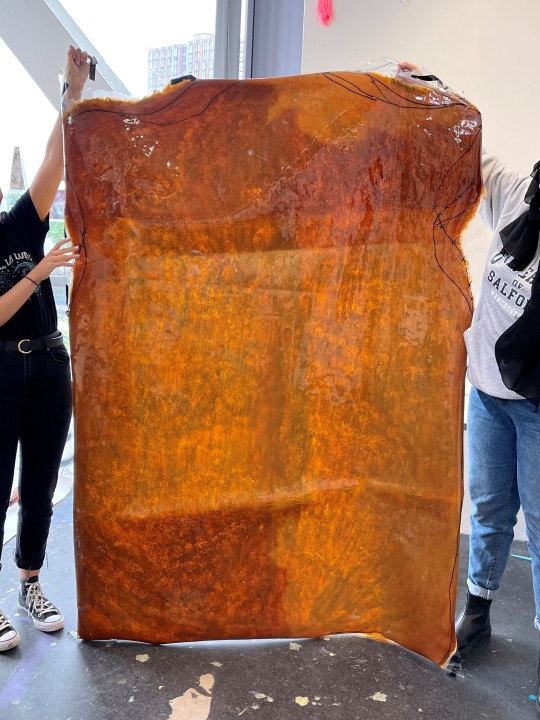

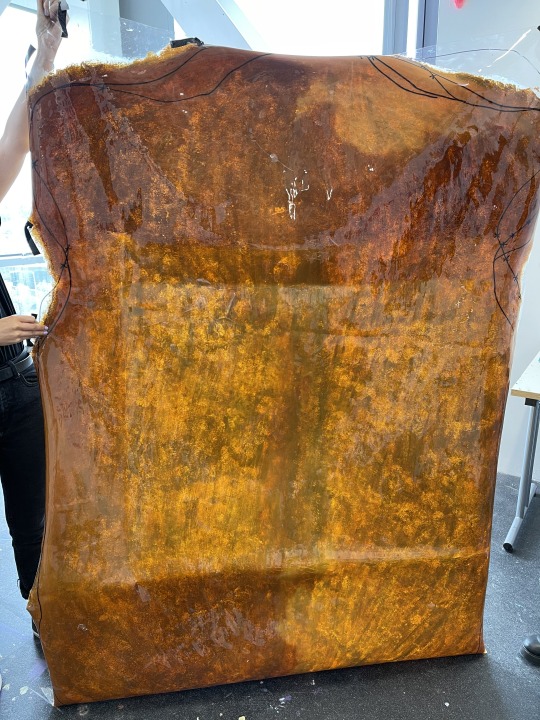

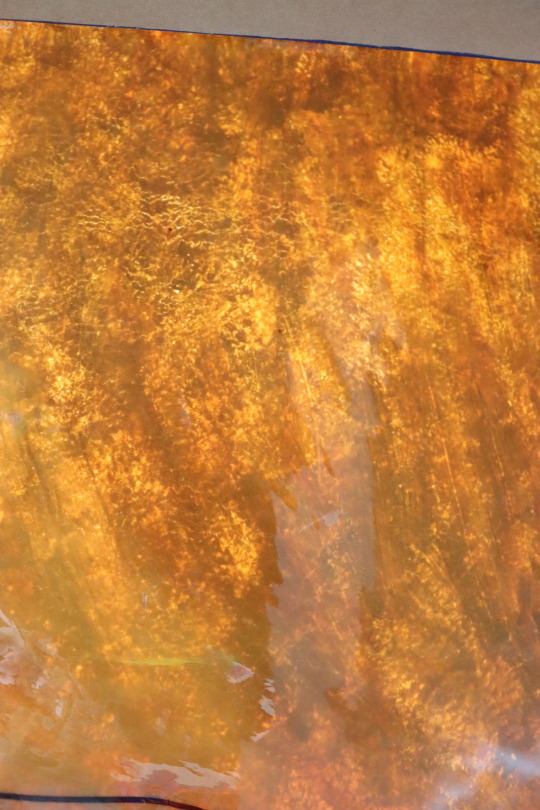
Two of my peers held my Latex (still on the PVC sheet) against the window, I knew the smaller versions that I had done looked better against the windowpane, but I wanted to make sure that I could still see all the details on each layer when it was a little further from the window but still had natural lighting. I am quite pleased with how it has turned out, I do however want to add a few more details with different coloured paint on to the Latex.
0 notes
Text
Responding to my pre-assessment feedback
In my pre-assessment feedback, David said that I had maintained my practice throughout the lengthy winter lockdown from home, I did this through my performative pieces and film project that I started and experimented with. Continuing to experiment with various materials and techniques, attending the workshop and making an animal hide out of Latex shows the level of ambition and commitment I have to my practice. David mentioned this in my feedback, saying that I had considered other methods of presentation throughout the semester – especially with my large-knitted piece. He said that by doing this, it fed into my work and created an interested dynamic between the materiality of the work and the methods of display and presentation. This is due to taking my work out into different environments and photographing these as separate works. The fibre-textile work is immersive, David said that the materiality of it has given my work a significant presence. He said that the time and effort of construction is engaging and should be emphasises, therefore I went back over the annotation on my posts and went into more detail about the process and why I chose the materials/techniques. David said I should consider the methods of presentation for my proposal; I did this through experimenting with the Latex against natural and artificial lighting and researching more into the framing of the Latex piece. David also mentioned emphasising the performance elements and the documentation of this, I did this by doing more research on performance artworks and how this feeds into my practice. Researching artists that also use juxtaposition in their work, referenced the photographs I took of my knitted-piece and tights in urban and rural settings. David mentioned this being the way I present my work at the exhibition, I did consider exhibiting photographs or video work, but wanted to make something physical for the exhibition. However, I can exhibit the digital work when showing the physical work is not possible (digital exhibitions, etc.). I agree with David on this work bringing more flexibility and potential.
When I had my pre-assessment tutorial, I had not put my contextual research on my blog yet – I had queued them and written some research out but not uploaded them. David said this must be significantly developed, I undertook a rigorous approach to this by using all resources to find artists and artworks that share similar interests of subject or theme and that also have good historical context. As David suggested, I researched Ernesto Neto, Caraoline Achaintre, Evgeny Antufiev, Phyllida Barlow, Barbara Chase-Ribour, Channing Hansen, Maria Nepomuceno, Shelia Pepe, and Shinique Smith, which I evidence on my blog. David also mentioned my portfolio review with Ann Bukantas and how she suggested looking at sculpture in 1960, 1970, and the 1980s. David also said how Ann had recommended the Arts Council Collection because I could use this to expose lots of work at one time. I used this as a resource to find sculptures from around that period and relating it back to my practice. David said I should look at artists who deal with similar issues in their art regarding animal rights, although I have researched these artists quite a bit when first experimenting with this theme, I did some more research. I found artists and artworks that were interesting, some not necessarily sharing the same view but have a unique approach to sculpture. David spoke about reflection and describing my processes in detail as a key to determining my grade and criteria for assessment. I understood this completely, so looked back through my annotated posts and went into further detail.
David then concluded my feedback by discussing my proposal for the Degree Show. He said it seems feasible, but I should consider whether using the frame for the Latex is necessary. I considered hanging the Latex straight from the wall and spoke to Sue Debny about it, I concluded that the frame has historical context about animal hide stretching, where they use basic frames. I evidence this research on my blog. David also said I should consider using artificial lighting and displaying the Latex in a darkened space with a more theatrical lighting. I experimented with both suggestions by making maquettes and holding the Latex up to natural light and artificial light. The final decision was that natural lighting would work better; it will show all the fine details that I have made on each layer of the Latex. This pre-assessment feedback was useful, and I feel it strengthened my contextual research and studio diary, understanding what the tutors are expecting in the submission.
0 notes
Text
Francesco Albano
youtube

On researching the juxtaposition in art, I further research abject art because I feel it is quite similar. I discovered Francesco Albano; he creates sculptures that resemble human form in unexpected ways. Skin, flesh, and bones are given rotting textures that result in grotesque sculptures.

His work is about disorder. “I have a strong attraction to deformity as the expression of the physical and mental decadence of the human body. I strive to depict those fleeting moments of personal collapse that modify the mind and the body, causing a breach between muscle, bone, and skin. An emotional breakdown, witness to a division caused by external pressure, is a collapse of intangible weight, and yet so overwhelming that the body is modified and crushed. On a visual level, deformity has its roots firmly planted in reality, in the memory and sensation of the tragic and ironic condition of human existence.” Albano’s work is abject, it makes the viewer feel disgusted and questioning what the material really it could be, because of the uncanny resembles of flesh.

Albano speaks about his practice and how playing with the material is important in his practice, he also says the necessity to record people and experiences of his life influences his artwork. Albano’s work is very interesting, the material he uses is fascinating and the results even more so. It looks so much like skin, it would be useful to experiment with similar materials to see if I could create similar work but of animal instead of human.

0 notes
Text
Juxtaposition in art



These also represent the abject in art.



David suggested I look at artwork and artists that use contrast to place objects in different environments to create juxtapositions. Through researching artists that use juxtaposition in their artwork, I discovered Kate Macdowell. Macdowell’s practice explores the conflicts that impact the environment such as, climate change, toxic pollution, and gm crops. Her inspirations stem from myth, art history, figures of speech, and other climate touchstones. Hand sculpting her pieces out of porcelain, she builds a solid form and then hollows it out.
0 notes
Text
Final Proposal



This is my final Degree Show Proposal, I decided to change the knitting so that it was hung from meat hooks instead of draped on the floor. I have updated the proposal and created a thorough document that shows my plans for the exhibition and how I am going to do them. I have spoken to Sue Debny who said she will help me make the frame for the Latex, I am going to do that the week after I submit my work so I can properly focus on making the frame and suspending the Latex. I have included the measurements for the meat hooks, frame, Latex, rope, and metal bar.
0 notes
Photo

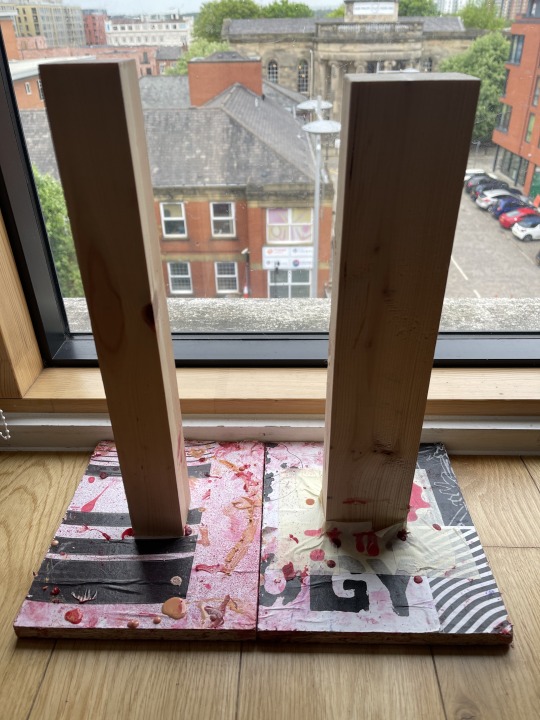
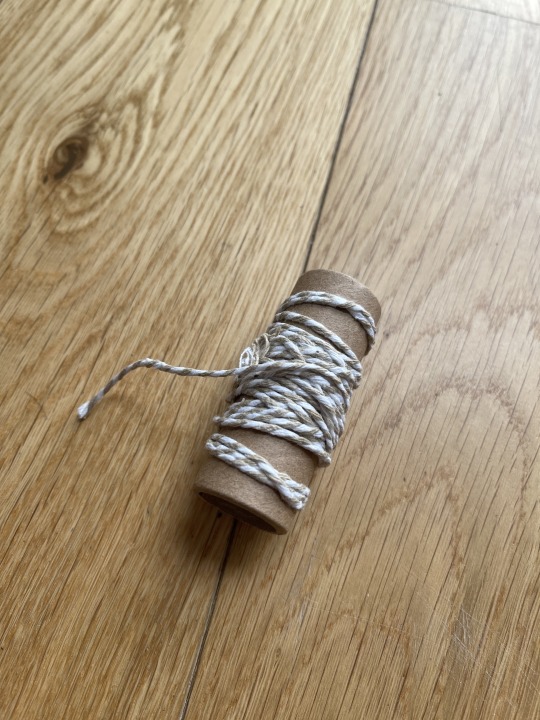
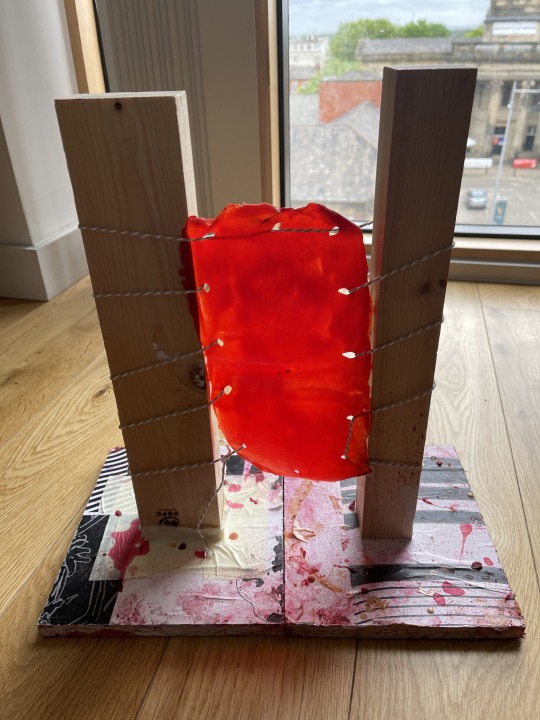
In my pre-assessment, David said I should consider the lighting for the exhibition and experiment with this prior to submission. I could use artificial studio lighting or natural lighting; I decided the best way to figure out which one to choose would be to experiment. I used one of my samples from last semester, cut holes in it about every 5cm and ravelled rope through it to suspend the Latex. This is a rough maquette of the larger sculpture I am making.


I placed the maquette up to natural lighting to see how well the Latex would light up. This Latex is quite thick, and the colour is strong, but you can see how the lighting shows the texture and detail within the Latex.
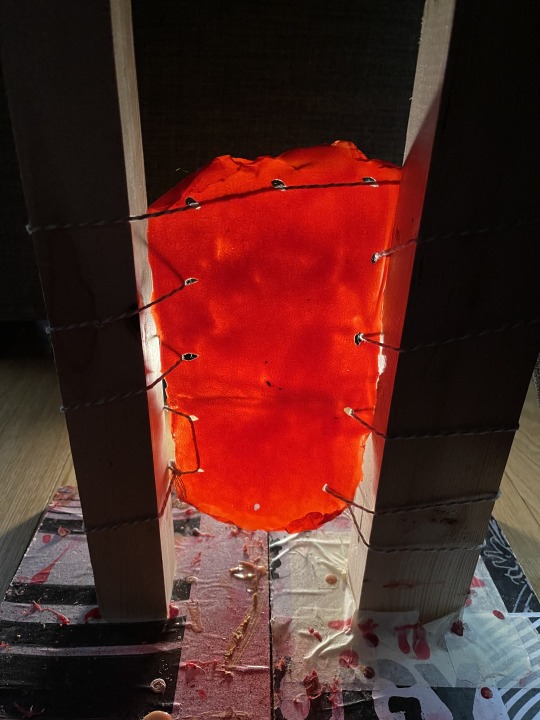
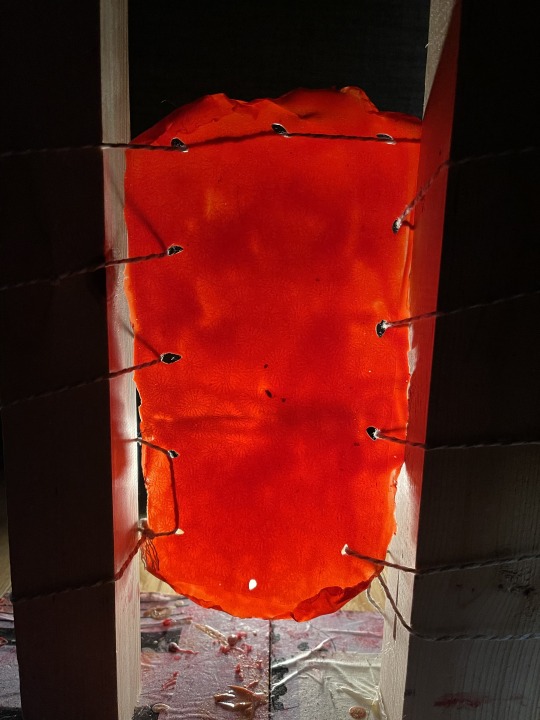
I then tried with a small studio light, it looked interesting, especially with the dark background which contrasts with the Latex. However, the piece will be much bigger, and I worry that the light would just focus on one bit, instead of the whole thing. I also want to exhibit my knitted piece alongside the Latex, and it would be too dark to see it. Although using the studio light could be more theatrical and dramatic, I feel the natural lighting would have a better effect on the Latex and more details will be shown.
0 notes
Text
Zoe Birrell
Upon researching vegan activist Zoe Birrell, she spoke about artists that inspire her practice. She mentioned Janine Antoni who is a visual artist, her body is both a tool for making and the source. Using her relationship to the world as inspiration for her practice.


For Saddle, Birrell made a cast of herself on all fours, draped over soaked cowhide, and created this piece. Freestanding, the piece resembles the vacancy of the artists body and the cow’s body. It would be interesting to see if I could do something similar with Latex, representing these things but using materials that are not derived from animals. Despite the use of cow skin, I think the hollow presence is moving and speaks a lot about how we use nonhuman animals – removing their skin from their body.

In 2038, Antoni is bathing in a trough, the cow is leaning over her, as though she is being nursed from the artist.
"I was ecstatic when our relationship had come full circle. I was weaned off my mother and onto the cow. Making the photograph allowed me to experience this intimate relationship: the cow becomes a wet nurse, a surrogate mother of sorts.”
Antoni’s work has a lot of meaning behind it, she speaks of the weird relationship humans share, being weaned off our mother’s breastmilk onto cow’s milk, yet does not see the absurdity. This is a perfect example on how society are influenced by “traditions” and the media, making us believe something so unnatural is normal.
0 notes
Text
Artists on animal rights
David said I should include artists who deal with similar issues regarding animal rights and the relationship we share with nonhuman animals. I have included artists that make work within this theme, but there are not many artists that incorporate this theme into their work.
youtube


Jacqueline Trade creates performances that reference the abuse that nonhuman animals endure from humans, in particular animal testing. Her work is interesting because of the concept, and when creating these performances in public – it starts a conversation.


Zoe Birrell is a vegan artist, this work is made by organic vegan chocolate, 480 cows, each made from 87% cocoa chocolate. Birrell speaks about her practice as a way to get the viewer to reflect on how we perceive and engage with society and the world around us, including nonhuman animals. “The fact that I am a woman, and I am creating an entirely female herd is not a coincidence as this herd is the result of the exploitation of another animals’ sexuality.” Although most of these were packaged and sold individually, it is an interesting concept for an artwork – especially as they are made from vegan chocolate.
0 notes
Text
Caroline Achaintre
David spoke about Caroline Achaintre, she is a mixed-media artist, and her work draws heavily upon primitivism and expressionism. Achaintre is interested in “the field of tension that is created between poles and antithetical conditions, in the viscosity of the moment of encounter, in transience.”


Her three-dimensional sculptures are made from watercolour, ceramic, bamboo, wool, and clay. They are abstract and figurative, which entices the viewer. The colour and shapes are vibrant and stand out, the material is durable – as exhibited outside. Achaintre’s interests lies within the duality which influences her material choice, she speaks about shaggy wool being both attractive and repulsive. I seem to take a similar approach with my practice, using materials that seem comforting and familiar, for reasons that are horrific and gruesome. Her work is interesting and doesn’t take the typical beauty that fabric art often aims to do, it tells another story and I sense a connotation to Native Americans/Tribe artwork and materials used.

0 notes
Text
Shinique Smith

Shinique Smith is an American visual artist, known for installations and paintings that incorporate textile and collage materials. She creates monumental abstractions of calligraphy textiles and collages.

Smith’s artwork represents her influences which consist of fashion, fane, graffiti, Japanese calligraphy, and poetry. “I am inspired and influenced by everything around me.” Smith talks about nature that has influences her artwork, the way people decorate our surroundings and how we dress and connect visually conceptually to the world around us. Using object such as clothing, fabric, toys, paper, cans, jewellery, stickers, and posters that she has collected throughout the years.

In an interview with MICA, Smith talks about how art has the potential to distil things that happen in society, and by doing so communicating to a wider audience which creates a deeper understanding of the world. “I think the best art doesn’t preach the truth but encourages viewers to discover what truth is on their own”, the way Smith speaks about art being a tool to communicate social and political issues through visual language thereby reaching a wider audience is inspirational and I completely agree. This is how I feel when I create art that is wanting to portray a message, something I am passionate about but in abstract ways. This concept relates to my practice, making art to evoke empathy, understanding, and expression it poetic and crucial. Smith talks about art as an important vehicle to nurture and empower young people.

0 notes
Text
Sheila Pepe

Shelia Pepe is a mixed-media artist who works in conceptualism, surrealism, and craft. Pepe addresses feminism and class issues through her abstract sculptures. Her large installations and sculptures are made from domestic and industrial fibres. Though Pepe uses materials that have connotations with feminine and craft traditions, and the sculptures interact with surroundings which could be criticising traditional museum boundaries, her artwork is left open to interpretations from the viewer.

“My interest lies in the risks we have to take to create to compelling work, I’ve pretty much shunned the rules we’re taught to abide by.” Pepe spoke about her practice and inspirations to a group of students, she said the biggest piece of advice she had was to explore the environment, to go out into your surroundings and experience the world. “Anything is grounds for inspiration.” She talks about her work being rooted to her lesbianism.

Pepe’s artwork is large in scale, it hangs from ceiling to floor, engaging with the environment of the gallery/museum. It is interesting how abstract and colourful her work is, and how it is more about the materials and techniques she uses to represent social or political issues.

0 notes
Text
Maria Nepomuceno

I have already included some work by Maria Nepomuceno in my contextual research but David had mentioned her in my pre-assessment feedback so I thought I would look more into how she makes the work and what her inspiration behind the work is. Nepomuceno is a Brazilian artist, best known for her knitted work that takes unusual forms and is quite figurative.

Made from rope weaving and straw braiding with branches, twigs, etc. Nepomuceno’s work pushes ancient traditions and craft techniques to create sculptures that resemble form, structure, space and are suggestive of animals, plants, the body, and landscapes.

Her work is beautiful, it is evident that there is an abundance of historical context with the materials and the techniques used to make these obscure sculptures. They look like bacteria, forms of plants, and growth from nature but made of vibrant colours.

“I think all art is intrinsically political, but there’s no longer necessarily an obvious political statement. But as the world becomes a more difficult place in which to live, people increasingly want to become more involved, it’s becoming more important. In my case, though, it’s not something I want be at the forefront of my work. I want to create a place where people can be suspended in time, in an environment where they can breathe and lose the notion of where they are, or what they’re doing or what the piece is for. I want to create an atmosphere that absorbs you, a place that’s about affect, ancestral connections and the future, about time, living and feeling alive, vital energy, that’s what I’m trying to create.” - https://www.studiointernational.com/index.php/maria-nepomuceno-interview

Nepomuceno says the surroundings and the environment influences her work greatly, she speaks about her desire to dominate the space and how she wants her work to have the presence to communicate with and dominate the settings. Her artwork is incredibly colourful, interactive with the surroundings, intriguing, playful, and fascinating. The form and colour are what intrigues me the most, the materials used are often quite hard, but her work looks soft in a way. She is a great artist to reference in my contextual research, for inspiration and visual stimulation, I also love the way Nepomuceno speaks about her work.

0 notes
Text
Channing Hansen

Channing Hansen is an American artist, using fibre-textiles as his primary medium. Hansen’s textile pieces are predetermined by a computer algorithm that generates infinite combinations of colour, fibre, pattern, and knit.

By using this algorithm, Hansen does not know how the piece will look until it is finished. Hansen collects, processes, and dyes raw fleece from conservation-bred sheep. I do not agree with the use of sheep wool, his work is abstract though and it is interesting how he uses a computer algorithm to determine what each work will look like, it would be interesting to see how this happens.

I like his pieces that engage with the surroundings, I can imagine they make the viewer feel fully immersed with the art. It would be interesting to create something similar with my fibre-textile work, all red yarn, fully spread out and becoming part of the environment.
0 notes
Text
Barbara Chase-Riboud

David spoke about Barbara Chase-Riboud in my pre-assessment feedback, Chase-Riboud is an American artist and poet. She is best known for her sculptures made of bronze and aluminium.

The Malcolm X Steels pay tribute to Malcolm X and his journey from a convict to a world leader. In this collection, Chase-Riboud combines textures and materials, they are described as contradictions “metal; bronze and silk, rigidity and fluidity, male and female”.

Also, a poet, this is one she wrote called Everytime a Knot is Undone, A God is Released.
Antony & Cleopatra The Year 40 B.C.
Whatever violence I have done thee, You've done to me tenfold. And so we stand quits and quivering, Two fools, In love without faith. For the honest love of one other Has made every man hate The dishonest love of another. For reasons of our own That tender thread We've lost Now I'll leave You alone.
“My interest in Cleopatra is based on my fascination with power as wielded by women throughout the ages. The concept of women ruling the earth and shaping society in immutable ways continues to be a revolutionary idea even though it has been a fact for eons.” Barbara talks about Cleopatra as an icon for modern women.

Chase-Riboud’s sculptures are grand, they have a sense of royalty because of the materials and colours she uses. They stand with pride and ownership which I think is beautiful. Her passion and the drive she has to make artwork and write poetry in response to global issues and historical figures is evident when you see the detail and presence of her work.
2 notes
·
View notes
Text
Phyllida Barlow
David suggested I include Phyllida Barlow in my contextual research. Barlow is a British artist, she takes inspiration from her surroundings, creating huge installations/sculptures from fairly cheap materials such as cardboard, plywood, polystyrene, fabric, and cement. I watched a documentary on Phyllida a while ago, she uses scaffolding and a team to make enormous sculptures. The process she uses is experimental and messy, she learns through taking risks and experimenting with how something looks after you have drilled, taken it apart, or added colour to it.

“The largeness of sculpture has that infinite possibility to make one engage beyond just the object itself and into other realms of experience.”
Phyllida describes her work as a strange medium that takes up space, that there is already too much stuff in the world, so she is fascinated with this absurdity or bringing more things in.
youtube
Representing Britain in the Venice Biennale 2017, Phyllida made huge baubles which she suggested could be ridiculous, humorous, comical, they could be leftovers, remains, foolish, celebratory. Her work at the Biennale was huge in size, the gallery was filled from floor to ceiling with heavy materials. They almost look intimidating, like they are balancing on top of one another.


Phyllida’s work is incredible, the ambition and size of her work is inspiring. It must have been amazing to view the work physically because I can only image how aweing it would have been to stand face-to-face with any of her sculptures.
0 notes